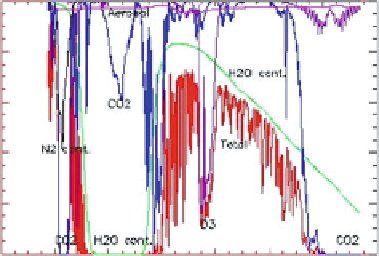Environmental Engineering Reference
In-Depth Information
Fig. 19.3
Atmospheric
transmittance vs. wavelength
for some typical absorbing
gases
1.0
1.0
0.8
0.8
0.6
0.6
0.4
0.4
0.2
0.2
0.0
0.0
2
4
6
8
10
12
14
16
Wavelength (micron)
Harris and Mason (
1992
) found that for a given change in surface temperature
ΔT
0
, the resulting changes in brightness temperatures in the two wavebands has the
following relationship:
ΔT
2
ΔT
1
¼
ε
2
ε
1
τ
2
ð
0
; p
0
Þ
(19.4)
τ
1
ð
0
; p
0
Þ
where
is the atmospheric transmittance, and subscripts
1 and 2 refer to the index of the two channels. The absorbing gases can be divided
into water vapor and other gases as follows:
ε
is the surface emissivity,
τ
τ
λ
0
ð
; p
0
Þ¼
exp
ð
k
w
λ
U
w
0
ð
; p
0
Þ
Þ
exp
ð
k
oλ
U
o
0
ð
; p
0
Þ
Þ
(19.5)
where
k
W
λ
and
k
o
λ
are the band-averaged absorption coefficients for water vapor
and other gases, respectively;
U
w
(0,
p
0
) and
U
o
(0,
p
0
) are the total column contents
of water vapor and other gases, respectively. Apply this to Eq.
19.4
, yields
ΔT
2
ΔT
1
¼
ε
2
ε
1
exp
ð
ð
k
w1
k
w2
ÞU
w
0
ð
; p
0
Þ
Þ
exp
ð
ð
ðk
o1
k
o2
ÞU
o
0
ð
; p
0
Þ
Þ
(19.6)
Assuming the magnitude (
k
w1
k
w2
) and
U
w
(0,
p
0
) is small, and it is reasonable to
take the first-order expansion. As
U
w
(0,
p
0
) is the total column water or precipitable
water
W
, we get
ΔT
2
ΔT
1
ε
2
ε
1
ð
1
þ KW þ
const
:Þ
(19.7)




Search WWH ::

Custom Search